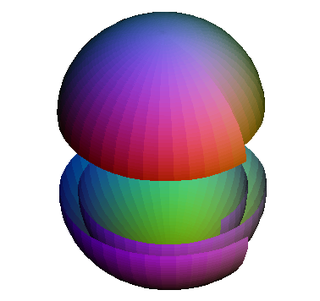Algebraic K-theory is a subject area in mathematics with connections to geometry, topology, ring theory, and number theory. Geometric, algebraic, and arithmetic objects are assigned objects called K-groups. These are groups in the sense of abstract algebra. They contain detailed information about the original object but are notoriously difficult to compute; for example, an important outstanding problem is to compute the K-groups of the integers.
In stable homotopy theory, a branch of mathematics, Morava K-theory is one of a collection of cohomology theories introduced in algebraic topology by Jack Morava in unpublished preprints in the early 1970s. For every prime number p (which is suppressed in the notation), it consists of theories K(n) for each nonnegative integer n, each a ring spectrum in the sense of homotopy theory. Johnson & Wilson (1975) published the first account of the theories.
In mathematics, complex cobordism is a generalized cohomology theory related to cobordism of manifolds. Its spectrum is denoted by MU. It is an exceptionally powerful cohomology theory, but can be quite hard to compute, so often instead of using it directly one uses some slightly weaker theories derived from it, such as Brown–Peterson cohomology or Morava K-theory, that are easier to compute.
In mathematics, specifically algebraic topology, an Eilenberg–MacLane space is a topological space with a single nontrivial homotopy group.

In the mathematical field of algebraic topology, the homotopy groups of spheres describe how spheres of various dimensions can wrap around each other. They are examples of topological invariants, which reflect, in algebraic terms, the structure of spheres viewed as topological spaces, forgetting about their precise geometry. Unlike homology groups, which are also topological invariants, the homotopy groups are surprisingly complex and difficult to compute.
In mathematics, the Adams spectral sequence is a spectral sequence introduced by J. Frank Adams (1958) which computes the stable homotopy groups of topological spaces. Like all spectral sequences, it is a computational tool; it relates homology theory to what is now called stable homotopy theory. It is a reformulation using homological algebra, and an extension, of a technique called 'killing homotopy groups' applied by the French school of Henri Cartan and Jean-Pierre Serre.
In mathematics, elliptic cohomology is a cohomology theory in the sense of algebraic topology. It is related to elliptic curves and modular forms.
In mathematics, the EHP spectral sequence is a spectral sequence used for inductively calculating the homotopy groups of spheres localized at some prime p. It is described in more detail in Ravenel and Mahowald (2001). It is related to the EHP long exact sequence of Whitehead (1953); the name "EHP" comes from the fact that George W. Whitehead named 3 of the maps of his sequence "E", "H", and "P".
In mathematics, Brown–Peterson cohomology is a generalized cohomology theory introduced by Edgar H. Brown and Franklin P. Peterson (1966), depending on a choice of prime p. It is described in detail by Douglas Ravenel . Its representing spectrum is denoted by BP.
In mathematics and specifically in topology, rational homotopy theory is a simplified version of homotopy theory for topological spaces, in which all torsion in the homotopy groups is ignored. It was founded by Dennis Sullivan (1977) and Daniel Quillen (1969). This simplification of homotopy theory makes certain calculations much easier.
In mathematics, the chromatic spectral sequence is a spectral sequence, introduced by Ravenel (1978), used for calculating the initial term of the Adams spectral sequence for Brown–Peterson cohomology, which is in turn used for calculating the stable homotopy groups of spheres.

Michael Jerome Hopkins is an American mathematician known for work in algebraic topology.
In mathematics, the norm residue isomorphism theorem is a long-sought result relating Milnor K-theory and Galois cohomology. The result has a relatively elementary formulation and at the same time represents the key juncture in the proofs of many seemingly unrelated theorems from abstract algebra, theory of quadratic forms, algebraic K-theory and the theory of motives. The theorem asserts that a certain statement holds true for any prime and any natural number . John Milnor speculated that this theorem might be true for and all , and this question became known as Milnor's conjecture. The general case was conjectured by Spencer Bloch and Kazuya Kato and became known as the Bloch–Kato conjecture or the motivic Bloch–Kato conjecture to distinguish it from the Bloch–Kato conjecture on values of L-functions. The norm residue isomorphism theorem was proved by Vladimir Voevodsky using a number of highly innovative results of Markus Rost.
In mathematics, a highly structured ring spectrum or -ring is an object in homotopy theory encoding a refinement of a multiplicative structure on a cohomology theory. A commutative version of an -ring is called an -ring. While originally motivated by questions of geometric topology and bundle theory, they are today most often used in stable homotopy theory.
Mark Edward Mahowald was an American mathematician known for work in algebraic topology.

Douglas Conner Ravenel is an American mathematician known for work in algebraic topology.
In algebraic topology, the nilpotence theorem gives a condition for an element in the homotopy groups of a ring spectrum to be nilpotent, in terms of the complex cobordism spectrum . More precisely, it states that for any ring spectrum , the kernel of the map consists of nilpotent elements. It was conjectured by Douglas Ravenel (1984) and proved by Ethan S. Devinatz, Michael J. Hopkins, and Jeffrey H. Smith (1988).
In mathematics, the Ravenel conjectures are a set of mathematical conjectures in the field of stable homotopy theory posed by Douglas Ravenel at the end of a paper published in 1984. It was earlier circulated in preprint. The problems involved have largely been resolved, with all but the "telescope conjecture" being proved in later papers by others. Ravenel's conjectures exerted influence on the field through the founding of the approach of chromatic homotopy theory.
This is a glossary of properties and concepts in algebraic topology in mathematics.









